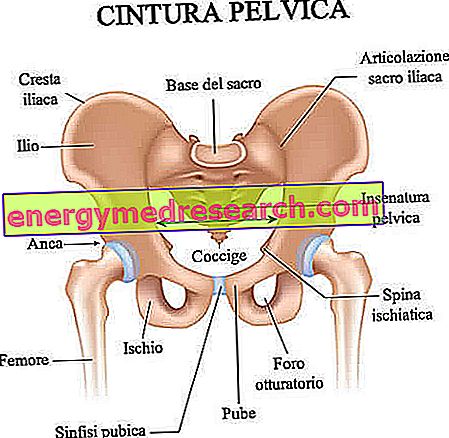Generality
Ilio is a part of the iliac bone. To be precise, it is the upper part - above both the ischium and the pubis - and of greater amplitude.
The iliac bone is the hip bone; it is an even element, which develops laterally to the sacrum and participates, with this and the coccyx, in the formation of the pelvic belt.
The ilium presents two anatomically interesting sections: the so-called body of the ilium and the so-called wing of the ilium.
The body borders on ischium and pubis and contributes to the formation of the acetabulum.
The wing, on the other hand, borders on the sacrum and creates a bone structure known as the iliac crest.
The ilium is the site of insertion of different muscles, including the external oblique abdomen, the buttocks (large, medium and small), the iliac muscle, the sartorius muscle, etc.
Together with the other bones of the pelvis, the ilium supports the upper part of the human body.

What is ilio?
Ilio is one of the three bony portions that make up the iliac bone .
To be precise, of the three portions that make up the iliac bone, it is the one located higher and of greater amplitude.
The iliac bone, also known as hip bone, is the even and symmetrical bone, which, together with the sacrum and coccyx, constitutes that anatomical structure identified with the name of pelvic girdle .
THE OTHER PORTIONS OF THE ILIAC BONE
The other two portions of the iliac bone are the ischium and the pubis .
Ischio and pubis both develop inferiorly to the ileus, but, while the former projects backwards, the latter moves forward, joining the pubis of the contralateral iliac bone and forming the so-called pubic symphysis .
ILIO IS PART OF THE BONE OF THE BASIN
The iliac bone - with its three portions ilium, ischium and pubis - and the binomial sacro-coccyx represent the so-called pelvic bones .
The anatomists call the lower part of the trunk of the human body the pelvis or pelvis .
Located between the abdomen and thighs, the pelvis includes, in addition to the pelvic bones: the so-called pelvic cavity, the so-called pelvic floor and the so-called perineum.
Anatomy
From the anatomical point of view, the ilium presents two relevant sections, known as the body of the ilium and wing of the ilium .
BODY
The body of the ilium is the section of the ilium that borders on the ischium and the pubis: with respect to the body, ischium and pubis both reside inferiorly, but, while the former develops backwards, the latter develops forward.
The body of the ilium includes part of the acetabulum ; the acetabulum is the hollow within which the head of the femur takes place, in what is called the hip joint .
WING
The wing of the ilium is the section that:
- Resides above the body;
- It connects to the sacrum, forming an important joint known as the sacral iliac joint ;
- It gives life to a bone structure, certainly known to most people, called with the name of iliac crest .
On the wing, two surfaces are recognizable: the inner surface (or iliac fossa ) and the external surface (or gluteal surface ). The iliac fossa is concave and represents the point of origin of the iliac muscle ; the gluteal surface, on the other hand, is convex, has semicircular lines called gluteal lines (anterior gluteal line, posterior gluteal line and inferior gluteal line) and represents the attachment point of the buttocks (NB: for more information on the muscles of the ilium si see the part dedicated to the "functions of the ilium").
Furthermore, on the lateral edges, with both anterior and posterior orientation, the wing has bony prominences that are called thorns : oriented forward, the so-called anterior superior iliac spine and anterior inferior iliac spine develop; on the other hand, the so-called posterior superior iliac spine and the inferior posterior iliac spine come to life.
Development
The three sections of the iliac bone - ilium, ischium and pubis - are fused together.
The fusion of the aforementioned sections is a process that takes place in the human being around the 14th / 15th year of life.
Function
The pelvic bones, of which the ilium is in fact one of the various components, have at least three noteworthy tasks:
- Support the upper part of the body;
- Connect the axial skeleton (which includes the skull, the vertebral column, the thoracic cage etc.) to the lower limbs;
- Give insertion to muscles, ligaments and tendons, fundamental for walking and not only.
ILIO AND ARTICULATION OF THE HOOK
As stated, ilio takes part in the hip joint, as it participates in the formation of the acetabulum.
The hip is the even joint element that allows the human being to stand upright, walk, run, jump, etc.
ILIO AND MUSCOLI
The muscles that relate to the ilium are:
- The external oblique abdominal muscle . It is a muscle of the abdomen, which originates at the level of the ribs and has several insertions: in the iliac crest, in the pubic tubercle and in the linea alba.
- The multifidus muscle . It has several points of origin, including the upper posterior iliac spine. It's a back muscle.
- The gluteus maximus muscle . It is a muscle of the bum, which has more points of origin, including the posterior gluteal line and the rough portion of the iliac crest.
It ends at the level of the gluteal tuberosity of the femur and in the so-called iliotibial tract.
- The gluteus medius muscle . It is a muscle of the bum, which originates on the external surface of the ilium, in the area between the iliac crest and the posterior gluteal line (NB: it is just below the large gluteal muscle).
Ends in the large trochanter of the femur.
- The small gluteal muscle . It is a muscle of the bum, which originates on the outer surface, in the area between the anterior gluteal line and the inferior gluteal line. It is born just below the average gluteus muscle.
Ends in the large trochanter of the femur.
- Iliac muscle . It originates in the iliac fossa and ends at the base of the small trochanter of the femur. It serves for flexion and lateral rotation of the thigh.
- The sartorius muscle . It is an anterior thigh muscle. It originates from the anterior superior iliac spine and ends at the level of the goose leg of the tibia.
- The large dorsal muscle . It is the largest muscle in the human body. It originates in several points: in the vertebral column section between the seventh thoracic vertebra and the fifth lumbar vertebra, in the iliac crest, in the inferior angle of the scapula, in the thoracolumbar fascia and in the last 3-4 ribs.
Ends in the intertubercular sulcus of the humerus.
Associated pathologies
Among the pathologies that can affect ilio, bone fractures and hip pathologies, with specific involvement of the acetabulum, certainly deserve a mention.
ANCIENT PATHOLOGIES
The two most important hip pathologies, which can derive from an abnormality of the acetabulum, are: coxarthrosis (or osteoarthritis of the hip) and congenital dysplasia of the hip .
Note : all three portions of the iliac bone participate in the formation of the acetabulum, so not only the ilium but also the ischium and pubis.
BONE FRACTURES
Fractures against the ile are traumatic injuries, which usually occur after accidental falls, car accidents or impacts during the practice of sports where physical contact is required (eg rugby, American football, etc.) .
The areas of the ilium most prone to fracture are the wings.
Fractures of the ilium can be divided into two categories: stable fractures and unstable fractures. All fractures characterized by a single breaking point are stable; all fractures marked by a two or more break points are unstable.
A severe fractured ally can result in damage to the bladder or urethra.



